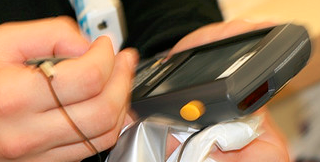Why POS Mobility is Becoming a Trend Among Top Retailers
 The current retail marketplace is precarious for companies that aren’t already considering an integrated mobile experience outside the shopping lane. A recent Forrester Research report predicts a rapidly approaching mobile explosion: if their prediction is correct, one billion consumers will have smartphones by 2016.
The current retail marketplace is precarious for companies that aren’t already considering an integrated mobile experience outside the shopping lane. A recent Forrester Research report predicts a rapidly approaching mobile explosion: if their prediction is correct, one billion consumers will have smartphones by 2016.
Retailers under pressure to differentiate their customer service experience from their competitors are optimistic about the potential for mobile to provide a branded, engaging experience to customers. They believe that by using mobile POS strategically they can help solve tough retail pain points such as line busting or building customer loyalty. It’s a safe bet that retailers who target mobile POS now, in its early stages, will flourish into the decade, while companies without mobility are likely to seem archaic to customers throughout the anticipated mobile explosion.
In this article, we’ll look more closely at the research compiled by the Aberdeen Research Report, “Retailers Target POS Mobility for Engagement, Interactivity, and Revenue” pulling out some of the primary pressures and priorities which had led to an increased interest in POS Mobility among retailers.
1. Rapidly Changing Customer Preferences
One key takeaway from the Aberdeen Report is that many retailers (40%) named their inability to keep up with the service preferences of their customers as a key pressure point in 2010. In addition, though sixty percent of the 100 retailers claimed their current POS capabilities to be sub-par, less than half (42%) have begun integrating POS systems with their Customer Relationship Management (CRM) data.
The inability of retailers to provide a personalized customer experience is what makes the flexibility of mobile so attractive. Sixty-five percent of retailers targeted in the study claimed that mobile POS has already been identified as one of the key ways to help with line busting and decreasing customer service wait times. POS Mobility has also been defined as a key objective in the effort to modernize and augment the traditional POS experience to better meet customers’ growing technological and personal expectations.
2. Multi-system Integration with Applications
Multi-system integration with applications is important to top retailers. Forty-two percent of respondents named POS integration with other applications as a key priority as well as the implementation of dynamic marketing content through mobile devices (29%).
When you consider how many retailers (74%) operate in information silos as indicated by another Aberdeen Research Report, it makes sense that retailers would want to store customer information and purchase history all in one centralized database that could then integrate with multiple applications such as a mobile device.
However, to do so a retailer would first need to implement a quality ERP database that can handle complex data calls. It would also need to interface with a point of sale system such as the IBM SurePOS.™ that can be integrated with mobile devices and applications. Once you have an ERP database and a POS system complex enough to support mobile applications, the concept of POS mobility becomes more likely.
3. Mobile POS Applications Can Solve Retail Pain Points
The researchers in this study also identified several mobile integration priorities for top retailers. The ability to collect customer data and store it in a CRM (64%), cross-selling and up-selling (60%), and payment processing (60%) were named key target areas that companies pursuing mobile POS integration prioritize.
The interest in POS mobility makes sense when you consider that retailers often desire to know more about their customers, but don’t want to have them wait in longer checkout lines just to acquire this data. After waiting thirty minutes in a checkout line, many customers would balk at the concept of a “loyalty program”. This concern is one of the reasons why retailers today actually know very little about their customers. POS mobility helps speed up customer interactions outside of the checkout lane while providing a more engaging, personalized retail experience.
However, a word of caution: before a retailer can implement POS mobility, they first need to make sure they have the proper equipment that interfaces with the mobile device. One can guess that the desire for mobile POS has fueled the conversation around multi-integration, a key pressure point for retailers in this study. For example, an electronics retailer who wants to greet customers and ask them to join their loyalty program using a mobile device will need to first integrate the device with a secure ERP database that can store the collected data.
Once customer licenses have been scanned, information about the products they purchased will be stored in the future and then can be used to create personalized prompts a store clerk could use to cross-sell or up-sell merchandise. The marketing team could also use the information stored in the database to create campaigns which would send relevant marketing content directly the customer on their mobile phone or email based on customer behavior.
These are just a few of the reasons that Mobile POS is becoming a hot topic among top retailers who desire to make retail shopping relevant for the consumer while affecting the bottom line.
RECENT POSTS
 How to Bring Experiential Retail to Your Retail ChainFor business owners in mid-sized retail, mobile POS is [...]
How to Bring Experiential Retail to Your Retail ChainFor business owners in mid-sized retail, mobile POS is [...] Magstar Voted a Top Software Vendor on the 2024 RIS Software LeaderBoardFor business owners in mid-sized retail, mobile POS is [...]
Magstar Voted a Top Software Vendor on the 2024 RIS Software LeaderBoardFor business owners in mid-sized retail, mobile POS is [...] 5 Reasons to Implement a Mobile POS System at Your Retail ChainNever have your customers waiting in line again with [...]
5 Reasons to Implement a Mobile POS System at Your Retail ChainNever have your customers waiting in line again with [...]